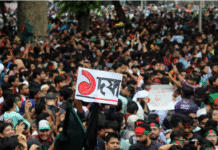
“Why do they even try? They don’t sound like us!” My mother was referring to the “bong” accents emulated by some of the Indian actors who occupy our living rooms every evening. That does not stop these characters from becoming regular guests of our evening party. They are beamed into our lives to remind us of a bordering culture that has become borderless, and millions of local viewers have embraced it as their own. They become a part of our “lived experience” as we identify with the presented characters, and our “real memories” as we process them as brain codes.
The popularity of pseudo-addiction to the melodrama of the Indian TV serials—the craving for a high-voltage family conflict or mushy-mushy romance, the traction of strange religiosity, the political intrigues or village politics—is helped by the viewing habits of our local audience. They thrive because there is a demand for such a brand of entertainment; they flourish because they have the open border and space to inundate our deltaic flood plain with the supply of such entertainment. The push and pull of these borderless TV bytes depict a dirty picture of entertainment, entertainment and entertainment—and the way we indulge in this entertainment logic tells a lot about our social identity and cultural behaviour. It shows the deep-rooted connection that lies at the hearts of the people who share the same language and culture.
Then again, how do I differentiate my binge-watching of Netflix or Amazon series from the viewing of these TV soaps? Why do many (of my social orientation or cultural background) adopt a moral and intellectual high ground while dismissing the so-called encroachment of the “sky culture” of Indian channels? While the high production cost of the series and selected viewership due to language may bracket these streaming services as “elite” pop culture, the Bangla serials—targeting mainly the female viewership with crafted “wishful identification”—may fall under the category of “mass culture”. Both have entertainment values as they activate our brains through releasing the happy hormone dopamine. Now, why do I cry havoc when a particular generation or gender finds it pleasurable to identify with the Bengali characters with a different accent, while another age or cultural group is drawn to a transnational experience? There are surely some double standards in the way we negotiate foreign media. But here, I will try to understand why such imported items find validity in our space and inform our responses.
While accompanying my mother in the TV room for the last few weeks, I have got some idea of all the plotlines of the drama serials aired by a popular Indian TV channel. The underlying motifs are very simple, yet fantastic: there is usually a woman who is socially marginalised because of her skin colour (e.g. Krishnakoli), lowly profession (e.g. Mithai the sweet maker’s daughter, Jamuna Dhaki the daughter of a temple drummer), or her rural background (e.g. Rimli). Somehow this female character is catapulted into an upper-class setting where she finds herself at the centre of a family drama. These central characters are usually shown as very honest, committed, dedicated and intelligent, but simple. They enact the mythical or stereotypical virtues of Indian women who have to be ready for the gambles of their husbands, for the humiliation in a public place, for the social, ethical and moral demarcation lines, as well as for the tenacity to pursue a husband’s love till death does the couple apart. The fantasy is teased through men from upper-class backgrounds taking interest in women from the lower class.
There is nothing extraordinary about the choreography, cinematography, dialogue or plotlines. One wonders why such dramas cannot be made here and parcelled abroad. Well, the ads promoting the app during the commercial breaks do hint that there is a trickle of cultural pushback from our enclaves, but that too through a limited corridor guarded by cultural custom officers and security censorship. The Indian media knows that they need some Bangladeshi dramas, characters and dialects in place to keep our local audience interested. Just like in IPL they need one or two of us (literally) to keep the local viewers engaged with the million-taka question: will they let him play tonight or not?
There was a court case a couple of years back when the cable TV operators were found guilty of showing programmes where Bangladeshi ads were being shown in foreign channels. Our tax-collectors were perturbed by the fact that the national audience were seeing local ads in foreign media outlets without paying them taxes—how dare they? They estimated that they were losing Tk 1,000 crore a year. Now the big question is, why do these local brands not come to the aid of local channels to revamp the quality of the content? Wishful thinking on my part.
The reality is that the Bangladeshi private television media is suffering as they never had the right business model to begin with. They are all competing in a very small market, and do not have the best technology and resources to open up their market to the outside world. The channels solely depend on ad revenues. The unhealthy competition in the industry has allowed the corporate sector to reduce ad fees, asking for more space against the price they are paying. In the process, our TV programmes have become the proverbial zebra: we do not know whether it is a black animal in white, or the other way round. In other words, we do not know whether we are watching ads during dramas or dramas during ads. Thus, we have left our zebras alone and changed channels to throng before the cages of a motley horse that tames the audience with its circus tricks.
Why can’t we have our own horses? The nationalist in me will bleed. Well, it’s easy for trucks to cross borders, but not your cultural horses! Apparently, Bangladeshi channel owners find it difficult to match the downlinking fees of Rs 15 lakh and the net worth of Tk 5 crore that a company needs to have in its base country. The figures do not sound that daunting given the ones that are rumoured to fly out of the country every now and then.
The problem lies in a dearth of sincerity. The popularity of the Bangla TV serials shows that at a subconscious level, the citizens of both countries feel the push and pull to remain connected. They have some common ground to tread. But then again, the political and commercial interests do not often make these exchanges possible in a respectful manner.
With the Indian prime minister in town, sharing the glory of the 50th anniversary of our independence, one hopes that his visit would encourage his cohort to make the cultural and political exchanges more meaningful. The receptive audience shows that this new media is a strong platform where the imaginary borders that separate the people of the same language group can be reimagined.
Shamsad Mortuza is Pro-Vice-Chancellor of the University of Liberal Arts Bangladesh (ULAB), and a professor of English at Dhaka University (on leave).










